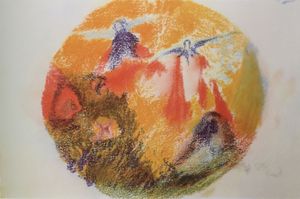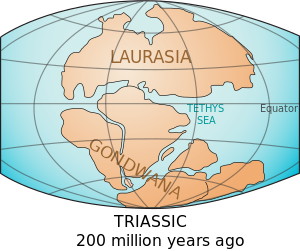Atlantis


The Atlantean age is the fourth of the seven main ages into which the present physical state of form of the Earth is divided. According to obsolete theosophical tradition, this main age is also called the fourth root race[1]. At that time, according to theosophical view, man lived predominantly on the Atlantic continent or island, called Atlantis (Greek: Ἀτλαντὶς νῆσος Atlantìs nēsos "Island of Atlas"), which according to Rudolf Steiner was located in the northern Atlantic Ocean between present-day Europe and America. The term "Atlantis" is considered scientifically outdated today, but it is essential for understanding Steiner's statements. It is possible that his descriptions refer to fragments of the former large continent of Laurasia.
The Atlantean period was preceded by the Lemurian period, in which man first incarnated on Earth, and is followed by the post-Atlantean period, which is divided into seven cultural epochs, the fifth of which is our present modern era.
Climate and location
According to Rudolf Steiner, the Atlantic period on the geological time scale began approximately with the Cenozoic (Lit.:GA 300a, p. 107), the beginning of which is placed at about 66 million years ago[1]. At that time, the climate was completely different from today. At the beginning it was still very warm. Later, about 2.6 million years ago, the most recent Ice Age began with the glaciation of the North Pole. At the South Pole, the Inland glaciation began 38 million years ago.
The air was saturated with water vapour and filled with fog vapours. About 11,700 years ago, with the subsiding of the Last Glacial Period and the beginning of the Holocene, the Atlantic Era came to an end. It was only at the end of the Atlantean period that the masses of fog began to settle and the sea level rose very rapidly as a result of the rapid warming, so that Atlantis finally sank in a massive flood. Plato still tells of the last remnant of this land, the island of Poseidonis, which is said to have been located westwards from Europe and Africa.
„Our root race, the Aryan[2], is descended from the most highly developed sub-race of the Atlantians, the Ur-Semitic, which last dwelt approximately in the region of present-day Ireland. The island of Poseidonis, mentioned by Plato, can be regarded as the last remnant of the declining Atlantis. Manu, a leading figure of the Atlantians, led the most mature people to the East.“ (Lit.:GA 94, p. 168)
„It was essentially the whole area that is now ocean, the ancient Atlantis, and there dwelt the physical ancestors of the present human race.“ (Lit.:GA 100, p. 125)
„The land was covered with vast masses of water-mist; these masses of water-mist were of different density in the first and in the last Atlantean period, namely they were different in the vicinity of present-day Ireland than in the other regions. The water and mist masses were warm and hot at first. In the southern part of the Atlantis they were still warm, partly hot, like warm, hot masses of smoke; towards the north they were colder.“ (Lit.:GA 101, p. 20)
„Let us look clairvoyantly at the old continent of the Atlantic world, which we must seek where the Atlantic Ocean is now, between Africa and Europe on the one hand and America on the other. This continent was enclosed by a kind of warm current, a current which clairvoyant consciousness shows to have risen, strange as it may sound, from the south, passing through the Baffins Bay towards northern Greenland and embracing it, then flowing over to the east, gradually cooling down, then in the time when Siberia and Rumania were in a state of heat, then, at the time when Siberia and Russia were far from being raised to the surface of the Earth, it flowed down in the region of the Urals, turned round, touched the eastern Carpathians, flowed into the region where the present Sahara is, and finally, at the Bay of Biscay, it went towards the Atlantic Ocean, so that it had a completely closed current area. You will understand that this current can only exist in its very last remnants. This stream is the Gulf Stream, which once flowed round the Atlantic continent.“ (Lit.:GA 121, p. 176f)
„What Germanic mythology calls Niflheim or Nebelheim - cloud home - is the land of the Atlantians. The Earth at that time was indeed warmer and still enveloped in a constant vapour envelope. The Atlantic continent was submerged by a series of torrential cloudbursts, in the course of which the Earth's atmosphere cleared. Only then did blue skies, thunderstorms, rain and rainbows appear. For this reason the Bible says that after Noah's ark landed, the rainbow became the new sign of the covenant between God and man.“ (Lit.:GA 94, p. 24f)
Geological clues
From today's geological point of view, based on plate tectonics, the continent described by Rudolf Steiner as Atlantis is probably best identified with fragments of the former large continent Laurasia, which broke away from the last supercontinent Pangaea about 200 million years ago in the younger Mesozoic. Gondwana, the southern large continent that became independent (again) with the disintegration of Pangaea, is presumably largely identical with Lemuria described by Rudolf Steiner. Antarctica, Australia and the Indian Plate had already detached from this southern continent at that time.
With the opening of the Atlantic Ocean, which began from the south about 150 million years ago, Laurasia gradually split into Eurasia and what is now North America. According to some sources, however, Laurasia still existed in a largely coherent form in the north until about 55 million years ago in the early Palaeogene, which already belongs to the Atlantic period. The South Atlantic had already opened wide at that time. Since the sea level was still much lower at that time, significant land bridges between the fragments, especially in the north, are likely to have existed for a long time later. From a geological point of view, a longer existence and the relatively rapid demise of southern Atlantis, of which Plato's Poseidonis is said to have been the very last remnant, seems particularly problematic. Andreas Delor has outlined an unusual solution to this (Lit.: Delor, 2011-2014).
The Atlantis as a completely new impact in the Earth's development
Only with the Atlantis did something really new begin in the Earth's evolution; all previous epochs were only repetitions of earlier stages of world evolution.
„Now let us take a look at this fourth period, the Atlantean, and what it represents. It was preceded by what I have often called the Lemurian period in Earth evolution, then by what we may call the second and the first period of Earth evolution. But these first three periods of Earth evolution up to the Atlantean period are repetitions: the first of the Saturnian Age, the second of the Solar Age, the third of the Lunar Age. Only the fourth, the Atlantean period, represents something new. The preceding periods are indeed repetitions, repetitions, however, on a higher level, but just repetitions.
The Atlantic period, that is, this fourth period, represents something new. And that which happened during the Atlantean period occurred when the Earth still had essentially different forms from those of later times. A solid Earth crust did not exist in the same sense in the middle of the Atlantic period as it does today. The geological periods that are assumed for these things are illusions. The times in which the earth solidified from its relatively solid-liquid composition still lie in the Atlantean period. And the human race was quite different during the Atlantean period. In the middle of the Atlantean period it did not yet have the solid bone structure of today. Men in their formation at that time actually resembled substantially more or less lower animals, not in their form - in their form they were very nobly formed - but substantially they resembled lower jellyfish-like animals in soft, cartilaginous substance.“ (Lit.:GA 346, p. 168f)
Literature
- Dankmar Bosse: Die gemeinsame Evolution von Erde und Mensch: Entwurf einer Geologie und Paläontologie der lebendigen Erde, Verlag Freies Geistesleben, Stuttgat 2002, ISBN 978-3772515934
- Ignatius Donelly: Atlantis, The Antediluvian World, 1882
- William Scott-Elliot: The Story of Atlantis, 1896
- Andreas Delor: Kampf um Atlantis. Ein Beitrag zur anthroposophischen Atlantis-Diskussion, Info 3 Vlg., Frankfurt a.M. 2004
- Andreas Delor: Atlantis nach neuesten hellsichtigen und wissenschaftlichen Quellen, Bände 1 - 8, Vlg. Ch. Möllmann, Borchen 2011 - 2016 ( http://www.andreas-delor.com/index.php?id=43 )
- Rudolf Steiner: Aus der Akasha-Chronik, GA 11 (1904 - 1908), Kapitel Unsere atlantischen Vorfahren English: rsarchive.org German: pdf pdf(2) html mobi epub archive.org
- Rudolf Steiner: Die okkulten Wahrheiten alter Mythen und Sagen, GA 92 (1999), ISBN 3-7274-0920-7 English: rsarchive.org German: pdf pdf(2) html mobi epub archive.org
- Rudolf Steiner: Grundelemente der Esoterik, GA 93a (1976), Berlin, 16. Oktober 1905
- Rudolf Steiner: Kosmogonie, GA 94 (2001), ISBN 3-7274-0940-1 English: rsarchive.org German: pdf pdf(2) html mobi epub archive.org
- Rudolf Steiner: Die Theosophie des Rosenkreuzers, GA 99 (1985), ISBN 3-7274-0990-8 English: rsarchive.org German: pdf pdf(2) html mobi epub archive.org
- Rudolf Steiner: Menschheitsentwickelung und Christus-Erkenntnis, GA 100 (1981), ISBN 3-7274-1000-0 English: rsarchive.org German: pdf pdf(2) html mobi epub archive.org
- Rudolf Steiner: Mythen und Sagen. Okkulte Zeichen und Symbole, GA 101 (1992), ISBN 3-7274-1010-8 English: rsarchive.org German: pdf pdf(2) html mobi epub archive.org
- Rudolf Steiner: Das Johannes-Evangelium, GA 103 (1995), ISBN 3-7274-1030-2 English: rsarchive.org German: pdf pdf(2) html mobi epub archive.org
- Rudolf Steiner: Welt, Erde und Mensch , GA 105 (1983), ISBN 3-7274-1050-7 English: rsarchive.org German: pdf pdf(2) html mobi epub archive.org
- Rudolf Steiner: Ägyptische Mythen und Mysterien, GA 106 (Dornach 1992), Vortrag vom 4.09.1908
- Rudolf Steiner: Geisteswissenschaftliche Menschenkunde, GA 107 (1988), ISBN 3-7274-1070-1 English: rsarchive.org German: pdf pdf(2) html mobi epub archive.org
- Rudolf Steiner: Die Mission einzelner Volksseelen im Zusammenhang mit der germanisch-nordischen Mythologie, GA 121 (1982), ISBN 3-7274-1210-0 English: rsarchive.org German: pdf pdf(2) html mobi epub archive.org
- Rudolf Steiner: Konferenzen mit den Lehrern der Freien Waldorfschule 1919 bis 1924, GA 300a (1995), ISBN 3-7274-3000-1
- Rudolf Steiner: Die vierte Dimension, GA 324a (1995), ISBN 3-7274-3245-4 English: rsarchive.org German: pdf pdf(2) html mobi epub archive.org
- Rudolf Steiner: Vorträge und Kurse über christlich-religiöses Wirken, V, GA 346 (2001), ISBN 3-7274-3460-0 English: rsarchive.org German: pdf pdf(2) html mobi epub archive.org
 |
References to the work of Rudolf Steiner follow Rudolf Steiner's Collected Works (CW or GA), Rudolf Steiner Verlag, Dornach/Switzerland, unless otherwise stated.
Email: verlag@steinerverlag.com URL: www.steinerverlag.com. Index to the Complete Works of Rudolf Steiner - Aelzina Books A complete list by Volume Number and a full list of known English translations you may also find at Rudolf Steiner's Collected Works Rudolf Steiner Archive - The largest online collection of Rudolf Steiner's books, lectures and articles in English. Rudolf Steiner Audio - Recorded and Read by Dale Brunsvold steinerbooks.org - Anthroposophic Press Inc. (USA) Rudolf Steiner Handbook - Christian Karl's proven standard work for orientation in Rudolf Steiner's Collected Works for free download as PDF. |
References
- ↑ cf. the table in Bosse 2002, p. 57
- ↑ These views of Steiner were in sharp contrast to the racial doctrine advocated by the [[w:Nazis|]], through which they wanted to glorify the Aryans as the supposed "master race". After Rudolf Steiner had already been fiercely opposed by the first representatives of National Socialism during his lifetime, the Anthroposophical Society was banned by Reinhard Heydrich's decree on 1 November 1935 "as a result of the antagonism between the views of the Anthroposophical Society and the nationalist ideas advocated by National Socialism".
